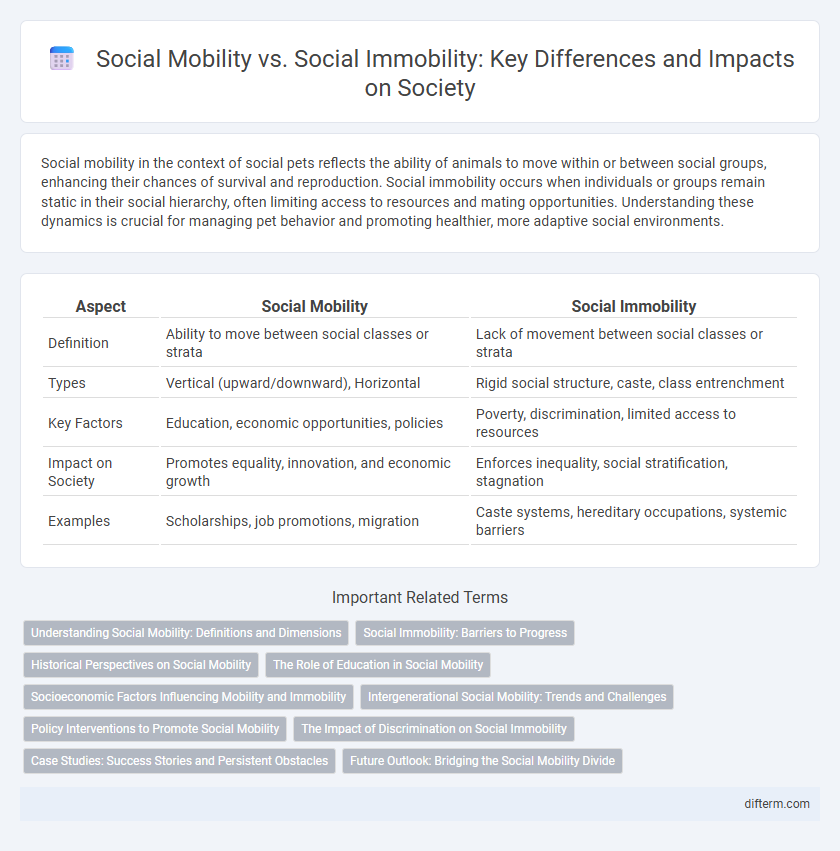Social mobility in the context of social pets reflects the ability of animals to move within or between social groups, enhancing their chances of survival and reproduction. Social immobility occurs when individuals or groups remain static in their social hierarchy, often limiting access to resources and mating opportunities. Understanding these dynamics is crucial for managing pet behavior and promoting healthier, more adaptive social environments.
Table of Comparison
| Aspect | Social Mobility | Social Immobility |
|---|---|---|
| Definition | Ability to move between social classes or strata | Lack of movement between social classes or strata |
| Types | Vertical (upward/downward), Horizontal | Rigid social structure, caste, class entrenchment |
| Key Factors | Education, economic opportunities, policies | Poverty, discrimination, limited access to resources |
| Impact on Society | Promotes equality, innovation, and economic growth | Enforces inequality, social stratification, stagnation |
| Examples | Scholarships, job promotions, migration | Caste systems, hereditary occupations, systemic barriers |
Understanding Social Mobility: Definitions and Dimensions
Social mobility refers to the movement of individuals or groups within or between social strata in a society, influencing economic status, education, and occupational opportunities. Key dimensions include intergenerational mobility, which measures changes in social status across generations, and intragenerational mobility, reflecting changes within an individual's lifetime. Understanding these dimensions reveals the degree of social immobility, where barriers prevent upward or downward shifts, highlighting structural inequalities and the persistence of social status across time.
Social Immobility: Barriers to Progress
Social immobility arises from entrenched barriers such as limited access to quality education, systemic economic inequality, and discriminatory labor markets, which restrict opportunities for upward movement. Structural factors like inherited wealth disparities and rigid class systems perpetuate cycles of poverty, limiting individual and community advancement. Addressing these obstacles requires targeted policies aimed at equalizing resource distribution and dismantling institutional biases.
Historical Perspectives on Social Mobility
Historical perspectives on social mobility reveal significant variations depending on cultural and economic contexts, with feudal societies exhibiting rigid social immobility due to hereditary class structures. The Industrial Revolution marked a turning point, enabling greater upward mobility through new economic opportunities and the rise of a middle class. However, persistent barriers such as unequal education access and systemic discrimination continue to limit social mobility in many modern societies.
The Role of Education in Social Mobility
Education serves as a critical catalyst for social mobility by equipping individuals with skills, knowledge, and credentials necessary to access better job opportunities and higher income brackets. Conversely, limited educational access and quality perpetuate social immobility, reinforcing cycles of poverty and inequality across generations. Investments in equitable education systems reduce disparities, fostering upward social movement and transforming socio-economic outcomes.
Socioeconomic Factors Influencing Mobility and Immobility
Socioeconomic factors such as education level, income disparity, and access to quality healthcare critically influence social mobility and immobility. Individuals from higher socioeconomic backgrounds typically experience greater upward mobility due to better resources and opportunities, while those in lower-income groups face structural barriers that reinforce immobility. Employment stability, neighborhood environment, and social networks also play significant roles in determining whether individuals can transcend socioeconomic constraints.
Intergenerational Social Mobility: Trends and Challenges
Intergenerational social mobility in many countries shows a persistent gap, with children from lower socioeconomic backgrounds facing limited opportunities to ascend the social ladder compared to their parents. Economic disparities, educational access, and labor market rigidities contribute to this stagnation, hindering upward mobility across generations. Policy interventions targeting quality education, equitable economic growth, and social safety nets are critical to overcoming these structural challenges and promoting greater social mobility.
Policy Interventions to Promote Social Mobility
Policy interventions to promote social mobility often include targeted education funding, affordable housing initiatives, and workforce development programs designed to reduce systemic barriers. Expanding access to quality early childhood education and vocational training significantly enhances upward mobility among disadvantaged groups. Social safety nets and progressive tax policies further support economic equity, enabling individuals to break cycles of social immobility.
The Impact of Discrimination on Social Immobility
Discrimination significantly hinders social mobility by limiting access to quality education, employment opportunities, and social networks for marginalized groups. Systemic biases in hiring practices and wage disparities reinforce economic inequality, perpetuating cycles of social immobility across generations. Addressing discrimination is crucial to breaking barriers and promoting equitable social advancement.
Case Studies: Success Stories and Persistent Obstacles
Case studies reveal that social mobility often thrives in environments with access to quality education, healthcare, and economic opportunities, as seen in examples like the rise of individuals from low-income backgrounds to influential leadership roles. However, persistent obstacles such as systemic inequality, discriminatory practices, and limited social networks continue to reinforce social immobility, trapping many in cycles of poverty. Effective policy interventions targeting these barriers are critical to transforming isolated success stories into widespread social advancement.
Future Outlook: Bridging the Social Mobility Divide
Innovative policies and targeted investments in education, workforce training, and affordable housing are crucial for bridging the social mobility divide, enabling historically marginalized groups to improve their economic status. Data from the OECD highlights that countries with robust social safety nets and inclusive labor markets experience higher rates of upward social mobility. Future outlooks emphasize the integration of technology and community-based initiatives to create equitable opportunities that reduce social immobility.
social mobility vs social immobility Infographic

 difterm.com
difterm.com